PART II in a three-part series: WHY BOULEVARD?
By Gayle Early
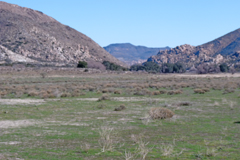 |
| Pristine vale in McCain Valley slated for transmission lines, including Sunrise PowerLink. (photo by Gayle Early) |
February 16, 2009 (Boulevard) — Iberdrola Renewables and other parties have had their fingers in the wind, testing for the past three years and more.
“If you link the windy areas in San Diego County to the transmission, it restricts you to very few areas. McCain Valley—and a small area around Julian—is one of the few areas in San Diego County that has wind anywhere near transmission,” said Andy Linehan, Permitting/Environmental Director of Iberdrola.
The quality of wind here might be questionable. Alan Ridley, Professor at Cuyamaca College and enthusiastic expert on renewable wind energy said, “I remember 10, 15 years ago a former Sempra employee told me they just can’t do wind energy in East County, because it’s the wrong kind of wind. I had a lawyer tell me that ‘Kumeyaay Wind project is good, but it’s not great.’
“A great wind plant is what they have in Palm Springs,” Ridley noted. “It’s a better resource area. The wind has only one place it can go, through that valley. It’s not going to stop and go over the mountains. It’s going to take the path of least resistance. It blows day and night, in the heat of the day when they need electricity the most.
“I don’t think wind energy in East County is futile, but one of the reasons we don’t have hundreds of thousands of turbines out there is because the resource isn’t as good as Tehachapi or Palm Springs or Altamont Pass,” he said.
Is it worth it? The up-front cost to the environment, to the neighbors, to wildlife? When wind plants operate at 30% efficiency?
Powerful Wind Arguments
“Fifty megawatts about 30% of the time is pretty darn good,” Ridley asserted. “With solar panels, you’re lucky if they’re 20%. Wind is less expensive when you get to the utility grade. In 2007, we paid something like $327 billion, I think it’s more than that for 2008, to import oil from [primarily] unfriendly countries. Would you like to have a couple extra billion dollars? If we can get more energy from our own resources, we wouldn’t need to buy oil from our best friends over there.”
Our country currently gets about 1% of its electricity from wind, up from 0.1% ten years ago. Studies from the U.S. Department of Energy, as noted in the Washington Post, concluded that wind harvested in the Great Plains states of Texas, Kansas, and North Dakota could provide enough electricity to power the entire nation, and that offshore wind farms could do the same job.
Further, wind blowing off the Great Lakes could generate 80% of the power we get from nonrenewables, according to David Bradley of Green Gold, a nonprofit organization supporting green business development. An AP article published in MSNBC stated that Michigan alone could proved a third of U.S. electricity demand, with a good 100,000 turbines.
But what of San Diego’s Smart Energy Plan calling for local generation of power and distributed generation? The smart-energy grid written into Obama’s stimulus plan is about as far off as Kansas. Southern California needs its juice now.
Residents revolt amid region hungry for energy
Iberdrola says that less than 2% of their BLM wind-lease area, that’s 7,000 acres, will be used for the actual wind facilities’ footprint, leaving room for hiking, camping, off-road vehicle use.
But for the folks nestled under the McCain Valley ridge, that’s 2% of the land and 100% of their sky. If all the turbine projects planned for the area get approved, these residents will be flanked on all sides.
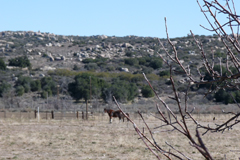 |
| McCain Valley Ridge, as viewed from Marie and Scott Morgans’ front porch. Each wind turbine dotting the ridgeline will be about 400 feet tall to the tip of the blade. (photo by Gayle Early) |
“It makes me sick when I go out my front door in the morning to feed my horses,” Marie Morgan said on the phone last week, imagining the altered landscape. “Each one of these will be taller than the SeaWorld tower!
“They’d be OK if not one person had to look at them. To make so much misery out here, and make money, it’s wrong. I personally couldn’t ruin someone’s life for money. We can go down fighting if we have to.”
Donna Tisdale, Boulevard Community Planning Group Chair, said, “People say it’s the fear of the unknown, but we actually know. We’ve got Kumeyaay Wind here. Even though it’s on sovereign land, it impacts people on nearby properties. Chronic noise. They have a distinctive whoosh and thump that’s constant. There’s some shadow flicker for people who live on the eastern side of the turbines, when the sun sets.”
For its part, Iberdrola is angling to meet the region’s hunger for energy. San Diego County alone sucked down a whopping 19-million megawatt hours of electricity in 2007, according to the California Energy Commission. American households use about a thousand kilowatt hours a month. (A megawatt is a thousand kilowatts.)
Alan Ridley cautions that 10,000 American homes is the equivalent of 50,000 European homes. “We’re such energy hogs. If we would use more natural light, run our washing machines at night, dry our clothes—do we have any sun in Southern California? Do we need a dryer?” he asked.
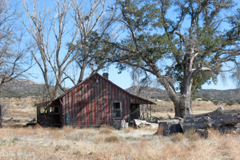 |
| McCain family homestead, built in the 1800s and occupied by the family until the 1980s. (photo by Gayle Early) |
“Wind plants really stabilize the grid now and provide a back up for us if we run out of natural gas or if natural gas-fired plants don’t work,” Ridley said. “You’ve got a back up in wind power and it’s a blessing, in my opinion.”
Of the Campo wind farm, five miles north, the McCain Valley residents say there is never a break from the chronic motion of the flipping arms. Many of them have lived for decades in a landscape where motion is transitory: leaves rustling in the oak and cottonwood trees, acorns dropping, countered by the Santa Anas that cruise in from the desert at 80 mph and whip up wildfires. For the most part it’s a slower pace: a butterfly dance, the sprint of a jackrabbit across an open field, the switch of a horsetail, the gallop of a dog trying to outpace the rare vehicle passing through.
Looking south, Sempra plans to install 200 turbines on 60 miles of ridgeline (the border is a mile and a half from Tisdale’s property). The Rumorosa Project on the Sierra Juarez range in Mexico is slated eventually to generate as much as 1,000 megawatts (that would take somewhere between 500 and 1000 turbines).
 |
| Sierra Juarez, in distance, where Sempra will install several hundred turbines. (photo by Gayle Early) |
Sempra, the mother company of SDG&E, is a multibillion dollar corporation that generates 2,600 megawatts for 29 million customers.
Ridgelines that used to fade into the shadows at night will be lit with blinking towers, a new vista for residents as well as visitors to the region. Private developers have snapped up acreage in the area to get in on the action, as well.
“We have all these carpet baggers and snake-oil salesmen out here, and now their latest shtick is wind,” Tisdale said.
Invenergy, an enterprising wind-development company, aggressively lobbied private property owners to sell rights of way. The company also has the ear of the county planning commission. After much urging, Tisdale, her husband, and another member of the planning group finally sat down to hear what the wind firm was were saying to their neighbors and wanted to say to them.
“They slid this contract across the table, had all of our parcel numbers. They never asked us, never told us anything. We didn’t even know it was coming.
“For about 15,000 bucks a year, they could do anything over, under, across, and through our property. MET [meterological testing] towers, wind turbines, substations, transmission lines—Which we flat turned down.”
And then?
“Invenergy accused my husband and I of being unpatriotic,” she said.
Three or four property owners have signed deals. “They’re absentee owners,” said Tisdale. “Mostly speculators. When you look into some of their backgrounds, it’s very questionable.
“One of them came to our planning group meeting. He claimed he went to the County, wanting to put up a wind turbine on his property. They said it would cost him $150,000 for a major use permit (MUP), and he needed to have some kind of wind testing before he knew it was worthwhile to put up a turbine.
“I told him that doesn’t make sense. Domestic turbines are allowed by right.” You don’t have to do an MUP if you do all the proper setback requirements. So he wasn’t being honest [admitting that he was looking into industrial-scale turbines].
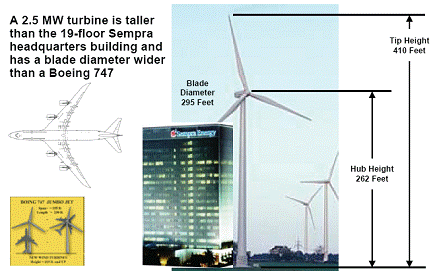 |
| Typical scale of industrial wind turbines. Iberdrola’s turbines will be 1.5 to 2.1 MW and 398-404 feet high. (image from Sempra website) |
“It’s happened before, they try to brow-beat you, make you feel guilty that you’re not promoting clean energy, that you need to accept this in your community for the greater good, what’s wrong with you, you’re a NIMBY [not in my backyard], and all that. People don’t understand. They don’t make the connection that we all moved out here to stay away from urban, industrial development.”
For their part, Iberdrola’s executives consider themselves “good neighbors.” Representatives attended a Boulevard town-hall meeting in December 2008, where they gave a PowerPoint presentation on their proposal and invited community comment and questions. They make themselves available with a toll-free community-outreach number at 1-(877) 753-5577, email contact at tulewind@communityspeakup.com, and are ready to listen and discuss their projects.
Winds of change
President Obama’s new stimulus package is blowing the necessary winds of change. In a one-two knock out punch, his administration hopes that investing in renewables and energy efficiency will save our overheating planet and at the same pull us back from our financial ledge. The momentum for wind development is huge.
Robert Pollin, co-author of Green Recovery: A Program to Create Good Jobs and Start Building a Low-Carbon Economy, recently wrote in The Nation that green investments create three times as many jobs as those in fossil-fuel production. More jobs, cleaner air, less dependence on oil companies and the ‘foreign oil oligarchies’: What’s not to like?
Making inroads with the BLM
Installing Iberdrola’s turbines in McCain Valley will require grading, road improvements and access-road construction, transmission lines, overall a great deal of up-front heavy-duty equipment and labor.
Each turbine requires about 50 square feet of land base (although a larger area will be graded initially to lay out the rotor, land which later will be reclaimed). As of now, semis won’t be able to get turbine parts under the freeway on McCain Valley road, so the company has sought rights of way through local properties. Their staging area will be in the Lark Canyon OHV recreation area.
Is the traditional environmentalist climate—where building logging roads through national forests or paving parts of Alaska’s snowy wilderness to reach a well incites outcry— yielding quietly to installation of roads and infrastructure on BLM lands, because of such critically needed renewable energy and the urgency of global warming?
A question of scale
The loudest complaints issue from the folks in Boulevard. For them, it’s mostly about quality of life. They raise concerns that will be voiced over fences across the country, especially in rural areas, as wind developers respond to federal and state incentives to get the blades spinning fast.
John and Iris Mauris left Alpine nine years ago because it got too crowded, “overdeveloped.” They took pains to build their house on their 35 acres in McCain Valley to blend in with the landscape. You can’t see their place until you’re right on it.
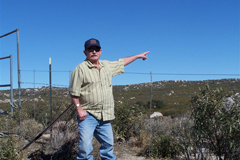 |
| John Mauris shows where the line of 400-foot turbines will stand. (photo by Leon Thompson) |
One of the chief criticisms of wind farms, as noted in American Wind Energy of America’s (AWEA) Siting Handbook, is when turbine developments are vastly out of scale with the landscape. In urban areas, homeowner associations endure CC&Rs, strict restrictions that prevent a person changing the color of house paint if it offends the neighbors. SeaWorld has had its battles over proposed towers dominating the beach skyline. The residents in Boulevard have few resources to protect the integrity of their skylines, even though it’s obvious to them that giant turbines do not harmonize with the landscape.
One recent morning, a few neighbors gathered in Marie and Scott Morgan’s kitchen for a coffee klatch. Their house is a modest one-story country dwelling, like most of the other homes nestled into this giant-boulder-speckled terrain. Marie and her husband and relatives nearby have lived here for 28 years.
The ridge proposed for development lies half a mile from Marie’s front porch.
“You mean that ridge, right there?” asked John, in his warm country twang.
Donna: “That ridgeline there, all the way, as far around as you can see.”
John: “What property is that?”
Donna: “BLM.”
John: “But that’s our property right over there. Why can’t we do something about it? Is the power going to stay here?”
Chorus: “No.”
Jerry: “It all goes north.”
John: “That’s crap.”
Scott Morgan commutes to National City, a 70-mile trek he trades off for the panoramic vistas, peace, and quiet of home. Others in Boulevard have commuted to LA and Oceanside so they can come home to a different world.
Linda: “We were supposed to get a cut in electric. I’m still waiting.”
Jerry: “We’re going to get a cut in electric. Because when the wind comes they shut our electric off.”
More chairs had to be rustled up as neighbors trickled. Marie served up strong coffee, but it wasn’t needed to stimulate discussion.
Leslie Wilson lives next door to Marie and gets the northern view of Campo wind farm. “The windmills you can see from the road, they don’t look five miles away. As the crow flies, they’re one mile.”
“They say they’re not noisy,” Leslie said. “I can hear them. On a quiet day you can hear them running. In the evening, it’s a constant whirring.”
Jerry: “It sounds like a truck on the freeway that never stops.”
Leslie: “And then there’s the night lights. Red and white, blinking.”
Jerry: “We came here for the stars. The quiet. Now we’ve got all these blinking lights.”
If you stand at the base of a windmill, it is relatively quiet, owing to modern technology and insulation in the nacelle. But, Tisdale said, “the sound propagates outward. We hear them out here.”
Horses near the turbines get spooked, they say. Almost everyone has horses in Boulevard. Or sheep, goats, donkeys, other farm animals. “Town” is a mom-and-pop feed store and a post office, that’s about it. When you go to Boulevard, you go back in time.
John: “People came up here to be left alone, to enjoy the rest of their lives. The quiet. And now we’re going to have all this activity.”
Iris: “They ruined Alpine. I used to call it Mira Mesa of the West. Once Deer Creek [housing tract] went in, it was just an open door for everything. I said, ‘let’s go.’”
John: “I built up here because I like the view.”
Marie Morgan had said over the phone, “Life out here isn’t easy, it can be so windy, it’s tough, it’s hard living. It takes a real pioneer spirit. Some people can’t do it.”
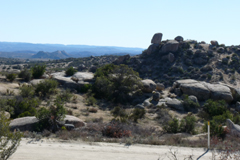 |
| BLM side of McCain Valley ridge downgraded scenically to allow industrial corridor (photo by Gayle Early) |
The Boulevard Planning Group submitted official comments to BLM on numerous occasions, protesting their area’s visual classification downgrade. In January 2009 Tisdale finally received a letter denying their protest; BLM had already approved the change months before. The letter was “very generic, a mixture of government-speak. You know, it takes them three letters to say ‘F-U,’” she told her neighbors.
BLM acted illegally, Planning Group Chair alleges
“I didn’t see any justification for downgrading this area,” Tisdale told ECM. She pored through piles of documents she requested through the Freedom of Information Act. “How can we go from VRM II (high scenic value) to VRM IV (industrial utility corridor)? You have to have a reason.
“We believe they illegally downgraded this area,” she said. “They just gutted the Eastern San Diego Plan without the legal process.”
Jerry: “It’s bad enough on one side, but every time you come out your door they’re gonna be in every direction. Whatever way the wind is blowing you’re going to hear the noise. And you’re going to see them.
“The average person isn’t going to notice it, but if you live here, it’s a constant thing.”
Jerry Yops is retired CHP, his wife, Diane, an elementary school principal. He wrote four letters to the BLM protesting the agency’s “just giving away our public lands, when they’re supposed to be our stewards.” There was no response from the BLM.
Tisdale added, ironically, that BLM alleged that Lark Canyon OHV trails (“which BLM allowed and didn’t patrol”) destroyed the area visually—“so much so, they said, that it would make 600-foot turbines allowable?!”
Besides the off-road vehicle disturbance in Lark Canyon, the BLM told Tisdale the Kumeyaay Wind Farm also had a part in degrading the area’s scenic classification—again, no small irony for the folks trying to protect their remaining views. (ECM’s calls to BLM for comment were not returned by deadline.)
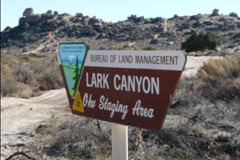 |
| Trails in Lark Canyon’s off-highway vehicle park mar landscape? (photo by Gayle Early) |
Leslie: “BLM are custodians of the public land and they’re selling us out for profit.”
John: “They haven’t asked us nothing. The people that are gonna have to look at it.”
Marie: “Poor Iris and John! They went out of their way to blend in, now ‘big deal,’ huh?”
Iris: “This summer they had a helicopter, took all day on a Saturday, flying with big deals hanging under the bottom, like cables. So they’ve already put stuff in there.”
Linda: “How are they gonna get that equipment up here?”
Donna: “They’re going down Ribbonwood and then through Walker’s, which is now owned by the Hamman Companies.”
John: “They’ll have to put a pretty good road in.”
Leslie: “Right in front of your house, Linda.”
Marie: “Those big trucks will scare the horses.”
Yops asserted, “This isn’t green energy. What does it cost to produce a windmill? Transport the parts out here, and set up. How long does it take to recover that input? It’s renewable energy, but we cannot call it green energy. And then you’re only getting, what, 20% efficiency at best [as occasionally quoted in the industry]? If this was such a great idea, private enterprise would have done this years ago, making money hand over fist. Instead they need government subsidies. We’re paying for everything.”
Donna: “They tell us it’s for the greater good.”
Iris: “For the greater good of La Jolla.”
Iris: “They’ll probably raise our taxes to help pay for them.”
Donna: “It’s a foreign corporation. They’re getting our public land. Our taxpayer-funded subsidies, they will be able to get renewable energy credits, and then they can sell their credits to polluting facilities.”
Spanish wind turbine meets heated opposition over project scale, scope
Iris: “For every windmill they put out here, they oughta put one in La Jolla.”
John: “They got a breeze off the ocean, don’t they? I think Torrey Pines would be a good place. Put it right up there.”
Leslie: “Mt. Soledad.”
Linda: “Point Loma!”
John: “And they don’t have far to go to distribute the power!”
Leslie: “I don’t think the people in Coronado are going to want to live with those there on Point Loma.”
Jerry: “Put a nuclear plant out on the coast. That’s where they need the energy, so put it out there. You can put it in their back yard.
In Iberdrola’s PowerPoint presentation, one slide showed windmill sites along the ridge, but it didn’t depict actual houses next to them. Another slide gave a visual of three wind turbines visible from I-8, but a great many more of these will be visible to property owners tucked into the hills surrounding the ridge.
Marie and Leslie: “We’ll stand there—just try to put a turbine in here! We’ll throw ourselves in front of the bulldozers!”
Marie: “They couldn’t offer me a million dollars. Seriously. To look at something that high.”
John: “What’s it going to do to our property values?”
Leslie, ironic: “Increases it! That’s what they’re saying.”
They all laughed.
Jerry: “Yeah, if you own all the windmills.”
 |
| John and Iris Mauris of Boulevard (photo by Leon Thompson) |
Impact on property values?
Wind’s trade-association AWEA lists studies with slightly increased property values, including increased tourism to wind farms. In only one study, however, did a researcher actually visit people’s homes.
Overall, said Laurie Jodziewicz, AWEA’s Manager of Siting Policy, “The studies we have don’t show any statistically significant impacts to property values.”
However, she added, “A family’s property is often their primary financial asset, so anything that would impact that is certainly a concern and really should be addressed. Some projects in some places have payments or arrangements with neighboring property owners; it’s really up to the developer and the community.”
After doing his own Internet research, Yops asserted that average property values go down 20%. “And we’re in a depressed area, anyway, we’re not getting top dollar for our houses, so we’re going down way more than 20%.”
Marie: “They wouldn’t build wind turbine farms in La Jolla. Out here, it’s OK to ruin our lives. We’re just little people. We don’t have the kind of money to kick them out.”
Morgan has a point. When Senator Edward Kennedy complained of a proposed off-shore wind farm in his Cape Cod skyline, he expressed concerns about dangers to sea life, birds, tourism, and fishing industries. Sounding a familiar tone, he also said “The interests of our state have been basically submerged to a special interest developer,” as quoted in an AP article.
Who gets to live next to energy projects? Some 50% of Americans live within 30 miles of coal-fired plants, according to 1Sky, a renewable energy advocacy group. Linehan pointed out that the electricity Boulevard relies on is probably being generated near someone else’s homes, as well.
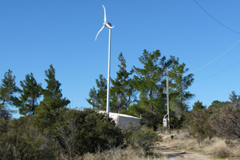 |
| Domestic turbines allowed by right on properties. A 15-foot diameter rotor on a 40-foot pole can supply 6000 kilowatt hours a year, enough for a small house. (photo by Gayle Early)Pristine vale in McCain Valley slated for transmission lines, including Sunrise PowerLink. (photo by Gayle Early) |
A local wind-energy entrepreneur, who spoke on condition on anonymity, championed the concept of smaller turbines for residences.. He explained that the ‘general model’ is larger turbines selling to the utilities, who buy at wholesale and sell at retail. “They get a mark-up and they meet their energy requirements.
“Everybody agrees with smaller scale projects,” he said, “except the utilities. They have no economic incentive to support that and they don’t like competition; they’re a ‘regulated’ monopoly. There are better compromises when you can use smaller turbines to get local benefits. The California Energy Commission provides about 50% of the cost of installing a turbine at your house, paid for by rate-payer subsidy. Distributed generation, feed-in tariffs—we should have a model like Germany.”
Even Donna Tisdale has a windmill pumping her well.
“We don’t want it to be like Palm Springs here,” the entrepreneur added. “There are appropriate places for wind turbines. We have to balance all the costs against the aesthetic costs. The economics of wind,” he stated, “are twice as good as solar.”
Who decides what kind of power we get? It depends on who’s in power.
One of the problems, the local wind industrialist said, is that ex-utility people head up our regulatory utility commissions. Their paradigm is big energy, old energy, large-scale transmission along the lines of Sunrise PowerLink. “Imagine if the head of the carriage builders’ association, in 1905, was put in charge of the transportation system of the future. When you had horse-drawn carriages, and not cars. There’s an inherent conflict of interest in the system.
“We have a flawed system, and it’s complicated,” he said. “The opposition [to wind energy] is divided. We need to come to some reasonable compromises, and it’s just not happening.”
Cheney ties—and a plan to triple size of project
Iberdrola expects to have its turbines up and running by 2011. BLM put its draft Plan of Development on hold while processing its Final Use Plan for McCain Valley, which involves tripling the 7,000 acres now available to Iberdrola.
According to Tisdale, BLM staff told her that former Vice President Dick Cheney's office called the El Centro BLM office to check on local BLM plan progress. “Only Iberdrola and/or SDG&E would care about the progress. It is all so convoluted and all about the money,” Tisdale wrote in an email, noting Cheney’s ties to Ken Lay, of ENRON, who allegedly manipulated renewable energy credits for wind energy—that is, selling them more than once.
A Taste of What’s to Come
Barack Obama has been an outspoken advocate of wind energy to meet America’s growing energy needs and reduce greenhouse admissions that contribute to global warming. Whether the Obama administration will follow the Bush administration’s lead in pushing for the wind energy project in McCain Valley, or whether new federal agency heads appointed by Obama may weigh in with a different view, remains to be seen.
Here’s Ken Salazar, in his confirmation statement as our new Secretary of the Interior: “As part of the President-Elect’s energy team, I will work to modernize our interstate electrical grid, expand the use of renewable energy like solar and wind on public lands, and help tribes develop renewable energy resources on their lands.”
Wind companies, sensing which way the winds of change are blowing, are poised to seize every opportunity.
Next week, in Part III, the final article in this series, ECM will examine the safety and environmental impacts of wind turbines, which have been linked to fire danger, health concerns, and even decapitations of birds and in one local case, a human. How rare or common are these potential hazards—and can they be mitigated?







Recent comments